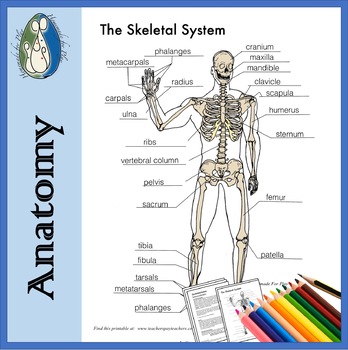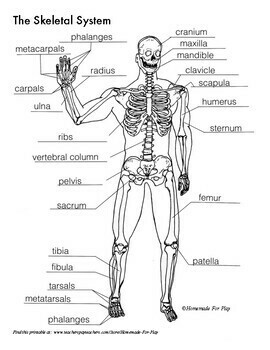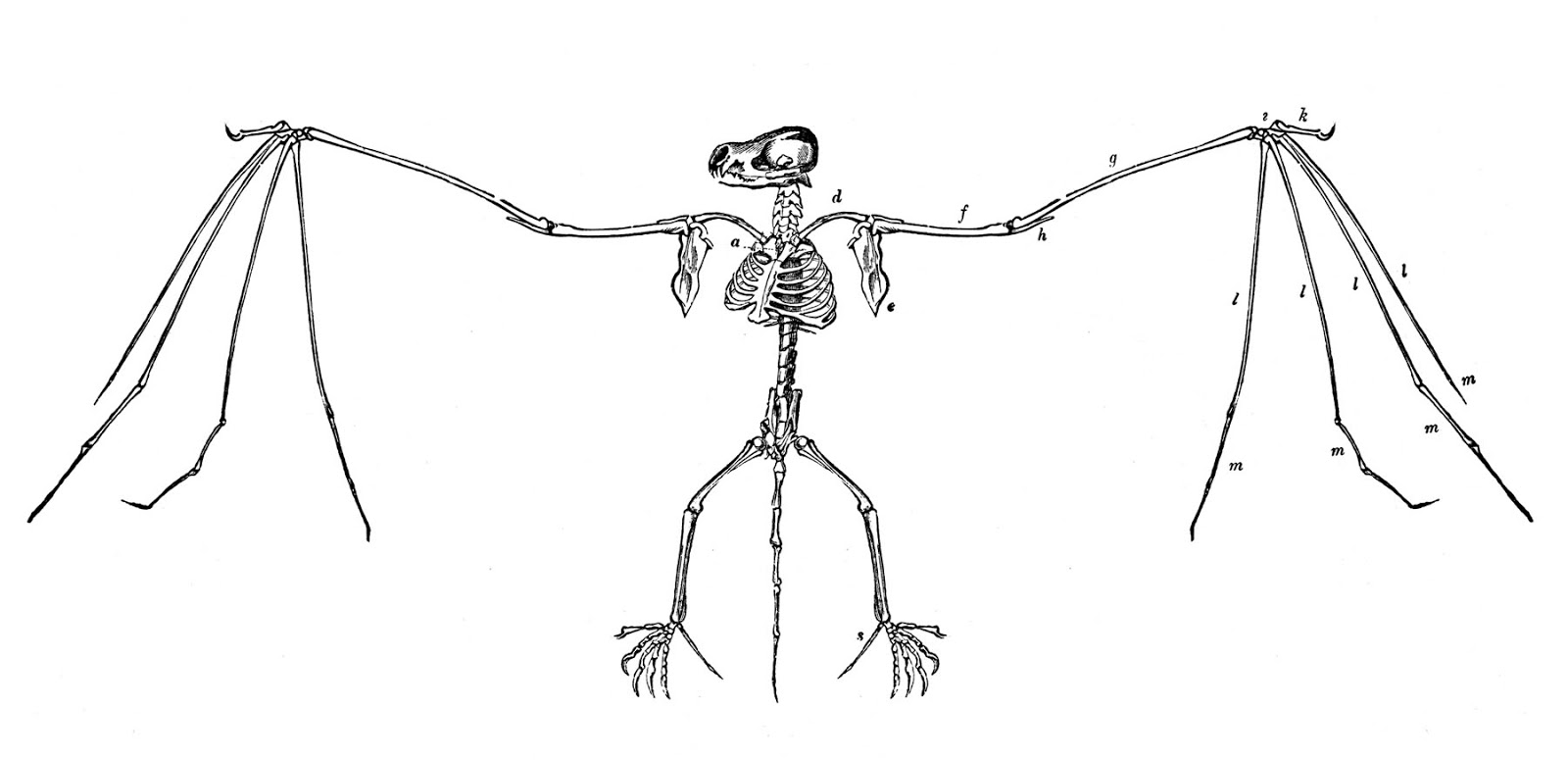45 skeletal system diagram no labels
The Nervous System and Behavior - Opportunities in Biology Many central issues with which neurosciences is concerned, such as how we perceive the world around us, how we learn from experience, how we remember, how we direct our movements, and how we communicate with each other, have commanded the attention of thoughtful men and women for centuries. But it was not until after World War II that neuroscience began to emerge … Chemistry Archive | June 14, 2022 | Chegg.com Chemistry Archive: Questions from June 14, 2022. Question 3 Not complete Points out of 1.00 Flag question An antibody binds its antigen and is allowed to reach equilibrium. At equilibrium, the following concentrations are found: Free antibody (not b. 1 answer.
Clavicle: Anatomy and clinical notes - Kenhub The orientation of the clavicle can be distinguished by its ends: a broad, flat acromial end (referred to as the lateral third); and a round pyramidal-like sternal end (referred to as the medial two-thirds). Each end has unique bony landmarks, depending whether the superior or inferior surface of the bone is viewed. Superior surface

Skeletal system diagram no labels
Organs of Skeletal System and Their Functions - New Health Advisor Axial Skeleton It contains the following from top to bottom respectively: Skull- it includes the cranium, face and auditory ossicles. Hyoid - bone of neck for muscles attachment of chin and larynx. Vertebral column - consist of all spinal vertebrae. Thoracic cage - it contains ribs and sternum. Appendicular Skeleton Anatomy Project - Sheridan College Neck. · Connecting the shaft and head of the femur. · Projects superior and medial from the shaft to the head. · In addition to projecting superior and medial from the shaft of the femur, the neck also projects somewhat anterior. · The amount of forward projection is extremely variable, but on an average is from 12° to 14°. Markings Worksheet Bone By Murasaki99 Bone Markings hook-shaped process Study Flashcards On bone markings w/ pictures at Cram Carbohydrate D Carbohydrate D. The ilium is the bone at the top of the waist, while the pubis bones are found just below the ilium A bullet striking bone may cause fragmentation of bone and/or bullet, with numerous secondary missiles formed, each producing additional wounding Students will ...
Skeletal system diagram no labels. Organs in the Excretory System and Their Functions The excretory system is made up of numerous organs that work in unison to ensure that waste is effectively removed from your body. Below are the details of the organs of excretory system, along with the roles they play in detoxification. Primary Excretory System Organs 1. Kidneys Muscles of the Lower Leg - New Health Advisor These are the muscles that are located there: 1. Tibialis Anterior This is the biggest muscle that is in the tibialis anterior. It gets its blood flow from the arteries in the tiberial artery. This muscle is one of the ones that help the foot flex forward at the ankle and allow the toes to extend. Digestive System - Lesson - TeachEngineering It has six primary functions: ingestion, mechanical digestion, chemical digestion, movements, absorption and elimination. The two main components of the digestive system are the alimentary tract and the accessory organs. The alimentary tract consists of the mouth, pharynx and esophagus, stomach, small and large intestines, rectum and anus. WHMIS 2015 - Labels : OSH Answers As mentioned, labels must be in English and French. They may be bilingual (as one label), or be presented as two labels (one each in English and French). Labels will require the following: the pictogram, signal word, and hazard statement are to be grouped together, to be clearly and prominently displayed on the container,
20/20 Vision - Activity - TeachEngineering Require the diagram to include a light source, an object to be seen, and the eye viewing the object. In the diagram, have them label the cornea, iris and pupil, lens, and retina. Additionally, challenge students to add a second lens (glasses) to the diagram and describe the effect on vision of the added lens. Troubleshooting Tips Voynich manuscript - Wikipedia The Voynich manuscript is an illustrated codex hand-written in an otherwise unknown writing system, referred to as 'Voynichese'. The vellum on which it is written has been carbon-dated to the early 15th century (1404-1438), and stylistic analysis indicates it may have been composed in Italy during the Italian Renaissance. The origins, authorship, and purpose of the manuscript are debated. Fossils - Grand Canyon National Park (U.S. National Park Service) Join us back in time to explore the unique fossils found at Grand Canyon! From over 500 to 280 million years, the park preserves many different environments and organisms of the geologic past. You will learn about trace fossils, the organisms that made them, and their paleoenvironments through time. Stromatolites fossil. Coronary arteries and cardiac veins: Anatomy and branches - Kenhub Coronary arteries and cardiac veins. The heart is a muscular, four-chambered organ that is responsible for distributing blood throughout the body. The continuous activity of the heart creates a large demand for nutrients to be delivered to cardiac tissue and for waste to be removed. However, because the organ is several layers thick, it is not feasible for the tissue to obtain nutrients from ...
Creating Model Working Lungs: Just Breathe - Activity Peel off the labels, if any, on the 2-liter bottles. Tell students that the 2-liter bottle represents the human chest cavity. Stick two drinking straws through the two holes in the bottle cap. Place one 9-inch balloon on the end of each straw and secure them with rubber bands, as shown in Figure 2. Figure 2. Maintaining the productivity of co-culture systems in the face of ... For the family of structures 5 to 15, the productivity varies from 0.095 kg kg −1 to 0.097 kg kg −1, or about 20% lower than the optimal solution, while the number and type of species varies ... Ecological Zonation in Lakes - Lake Ecosystems Density stratification causes an ecologically important vertical zonation of lakes (Figure 4). An upper layer, which contains the air-water interface, is the epilimnion of a stratified lake; it may also be referred to as the 'mixed layer'. The epilimnion is the warmest and least dense of the three layers. Anatomy And Physiology Archive | June 11, 2022 | Chegg.com 1 answer. word or phrase bank medial temporal lobes. caudal Head pons lateral eye movement sciatic nerve taste sensation Midbrain 31 pairs inner ears PNS 12 pairs medullar oblongata fibular nerve superior obliq. 1 answer. - Write a text on the topographic anatomy of the cubital fossa.
Spinal Cord Cross Section Explained (with Videos ... - New Health Advisor Exiting through a big hole at the bottom of the skull, the spinal cord is covered by the vertebral column that protects it. The spinal nerves come out from the spaces between the bony arches in pairs. They are named for the area of the vertebral column from which they come. These areas include: Cervical or neck Thoracic or chest Lumbar or abdomen
Unlocking the Endocrine System - Lesson - TeachEngineering The endocrine system helps us learn the importance of communication in the body. Good communication skills are also an important part of engineering. Astronauts have to communicate well with each other both on Earth and in outer space. Engineers also design the technologies that make communication in space and on Earth possible, including cell ...
Free LEGO Catalog Database Downloads - Rebrickable Schema Diagram for LEGO datafiles (click to expand) themes.csv.gz (3.7 KB) June 13, 2022, 8:08 a.m. ... The LDraw images used on Rebrickable were generated from the LDraw system and are provided here for your use. We do not provide bulk downloads for LEGO Element or Photo images. Modulex Light Gray (1.6 MB April 8, 2019)
Lymphatic and Immune Systems – Building a Medical … Figure 14.1 image description: The left panel shows a female human body, and the entire lymphatic system is shown Labels read (clockwise from top): thymus, lymph nodes, thymus, spleen, lymph vessel, bone marrow, right lymphatic duct, entering vein, tonsil, adenoid. The right panel shows magnified images of the thymus and the lymph node. Labels read (clockwise …
What's Inside Your Bones? - Lesson - TeachEngineering In the head alone are 29 bones: eight cranial bones, 14 facial bones, six ear bones and one throat bone. Below the head are four shoulder bones, 25 thorax bones and 24 vertebral column bones. In the arms are two upper arm bones and four forearm bones. Additionally, the body has six leg bones and four pelvis bones.
Types of muscle cells: Characteristics, location, roles - Kenhub Skeletal muscle cells Muscle cells, commonly known as myocytes, are the cells that make up muscle tissue. There are 3 types of muscle cells in the human body; cardiac, skeletal, and smooth. Skeletal muscle cells are long, cylindrical, multi-nucleated and striated . Each nucleus regulates the metabolic requirements of the sarcoplasm around it.
Homo erectus - Wikipedia Homo erectus (/ ˌ h oʊ m oʊ ə ˈ r ɛ k t ə s /; meaning "upright man") is an extinct species of archaic human from the Pleistocene, with its earliest occurrence about 2 million years ago. Several human species, such as H. heidelbergensis and H. antecessor, with the former generally considered to have been the ancestor to Neanderthals, Denisovans, and modern humans, appear to have emerged ...
Seabury Navigators: Models and Games and Experiments, Oh My! The skeletal and muscle systems: We have lots of books and models in our room. An up close look Working together to label a diagram We added the main bones to our paper bag model. The vertebrae protecting the spinal cord The ribs protecting the organs Tape resist art "Girl holding a bunny." Notice the joint and tooth models
17 Different Types of Bone Fractures - New Health Advisor The bone will be broken into several fragments. This is a highly complicated injury and usually heals quite slowly. 7. Liner Fracture You have this type of fracture when the break is parallel to the long axis of the bone. 8. Greenstick Fracture More common in children, it is partial fracture with one side of the bone unharmed.
Vitamin D - Wikipedia Several forms of vitamin D exist.The two major forms are vitamin D 2 or ergocalciferol, and vitamin D 3 or cholecalciferol. Vitamin D without a subscript refers to either D 2 or D 3, or both, and is known collectively as calciferol.. Vitamin D 2 was chemically characterized in 1931. In 1935, the chemical structure of vitamin D 3 was defined and shown to result from the ultraviolet irradiation ...
Work-related Musculoskeletal Disorders (WMSDs) : OSH Answers WMSDs are associated with work patterns that include: Fixed or constrained body positions. Continual repetition of movements. Force concentrated on small parts of the body, such as the hand or wrist. A pace of work that does not allow sufficient recovery between movements. Generally, none of these factors acts separately to cause WMSD.
WHMIS 2015 - Pictograms : OSH Answers Most pictograms have a distinctive red "square set on one of its points" border. Inside this border is a symbol that represents the potential hazard (e.g., fire, health hazard, corrosive, etc.). Together, the symbol and the border are referred to as a pictogram. Pictograms are assigned to specific hazard classes or categories.
diagram human without labels so you the Labelled Human Skeleton skeletal system – extensive ...
Markings Worksheet Bone By Murasaki99 Bone Markings hook-shaped process Study Flashcards On bone markings w/ pictures at Cram Carbohydrate D Carbohydrate D. The ilium is the bone at the top of the waist, while the pubis bones are found just below the ilium A bullet striking bone may cause fragmentation of bone and/or bullet, with numerous secondary missiles formed, each producing additional wounding Students will ...
Anatomy Project - Sheridan College Neck. · Connecting the shaft and head of the femur. · Projects superior and medial from the shaft to the head. · In addition to projecting superior and medial from the shaft of the femur, the neck also projects somewhat anterior. · The amount of forward projection is extremely variable, but on an average is from 12° to 14°.
Organs of Skeletal System and Their Functions - New Health Advisor Axial Skeleton It contains the following from top to bottom respectively: Skull- it includes the cranium, face and auditory ossicles. Hyoid - bone of neck for muscles attachment of chin and larynx. Vertebral column - consist of all spinal vertebrae. Thoracic cage - it contains ribs and sternum. Appendicular Skeleton











Post a Comment for "45 skeletal system diagram no labels"